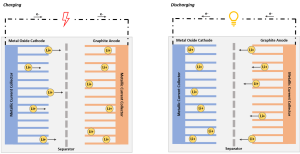Difference between revisions of "Lithium Ion Batteries"
Jump to navigation
Jump to search
| (One intermediate revision by the same user not shown) | |||
| Line 1: | Line 1: | ||
{{Energy Storage Technology Simple | {{Energy Storage Technology Simple | ||
|imgdesc=An image showing the general chemical structure of a lithium ion cell | |imgdesc=An image showing the general chemical structure of a lithium ion cell. <!--Image Source: The Economist (2002)<ref>The Economist: [https://www.economist.com/technology-quarterly/2002/06/22/hooked-on-lithium Hooked On Lithium (Jun. 22nd 2002)]</ref>--> | ||
}} | }} | ||
Latest revision as of 13:05, 21 December 2023
